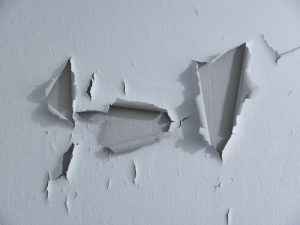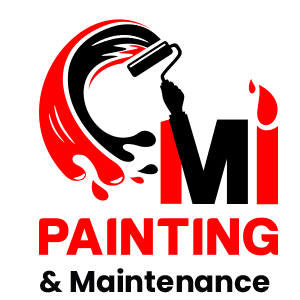Paint cracking on interior walls is a common issue faced by homeowners and commercial property owners. It’s not just an aesthetic problem—it can indicate underlying issues with your walls or the painting process itself. This article will explore the common causes of paint cracking and how you can prevent it from happening, ensuring your walls stay pristine for longer.
What are the common causes of paint cracking on interior walls?
Paint cracking happens when the top layers lose their ability to stick, resulting in visible fractures. Common causes include improper surface preparation, such as walls needing to be cleaned, patched, or primed. Moisture and humidity can also lead to peeling and cracking, particularly if walls aren’t sealed properly. Temperature fluctuations cause the paint to expand and contract, while low-quality paint tends to be thinner and more prone to cracks. Additionally, structural issues, such as foundation shifts, can stress the paint and cause cracking.
How does poor surface preparation lead to paint cracking?
Proper surface preparation is essential for ensuring that the paint adheres well and lasts longer. When the surface isn’t prepared correctly, paint can crack easily. Some factors that contribute to poor surface preparation include:
- Not cleaning the walls: Dust, dirt, or grease can prevent paint from adhering correctly.
- Inadequate priming: With a good primer, the paint may bond correctly to the surface, leading to cracks.
- Filling gaps poorly: Unfilled cracks or holes can cause stress points where the paint will eventually crack.
- Uneven surfaces: Irregularities in the wall can create pressure points, causing the paint to crack over time.
Can moisture and humidity contribute to paint cracking?
Yes, moisture and humidity are among the primary contributors to paint cracking. When walls are exposed to high moisture levels, the paint can become weakened and brittle. Common moisture-related issues include:
- Damp walls: If the wall has absorbed moisture due to leaks, condensation, or high humidity, paint can crack or peel.
- Bathroom or kitchen moisture: Rooms with high moisture content, like kitchens and bathrooms, are prone to paint damage if the correct type of paint or sealant isn’t used.
- Water leaks: Undetected leaks from plumbing can slowly damage both the walls and paint, eventually causing cracks.
- Condensation: The build-up of condensation can weaken the paint, making it more likely to crack.

What role does temperature fluctuation play in paint cracking?
Temperature fluctuations can cause the paint to expand and contract. These shifts put pressure on the paint, causing it to crack over time. Temperature-related issues include:
- Extreme heat: In Australia’s warming climate, paint can dry out too quickly and become brittle, leading to cracks.
- Sudden temperature changes: Rapid changes in temperature, especially in homes with poor insulation, can cause the paint to contract or expand, resulting in visible cracks.
- Cold temperatures: During the winter months, lower temperatures can cause the paint to become too rigid, making it more susceptible to cracking.
How do seasonal changes impact the durability of interior paint?
Seasonal changes can have a significant impact on the lifespan of interior paint. Factors such as humidity, temperature, and drying times vary throughout the year and affect how the paint behaves. Consider the following:
- Spring (Sep-Nov): The moderate temperatures and low humidity make this an ideal time to paint. The paint dries evenly and sticks well.
- Summer (Dec-Feb): Summer heat can cause paint to dry too quickly, resulting in cracks or an uneven finish.
- Autumn (Mar-May): As temperatures cool, autumn becomes an excellent time for painting, especially if you need to address exterior issues before winter.
- Winter (Jun-Aug): Winter’s cooler temperatures make it easier for paint to dry slowly, which can result in a smoother finish and better adhesion, especially for interior walls.
How can using low-quality paint result in paint cracking?
One of the critical factors in avoiding paint cracking is the quality of the paint used. Low-quality paints are often thinner and need more durability than premium options. Here’s why:
- Thinner formula: Cheap paints don’t adhere as well and tend to crack more easily under pressure or temperature changes.
- Weaker pigments: Low-quality paint may provide a different level of protection, making it more vulnerable to wear and cracking.
- Poor drying properties: Inferior paints tend to dry unevenly, leading to visible cracks in the surface.

Investing in high-quality interior paint in Sydney ensures a more durable finish and fewer chances of cracking over time.
Is paint deterioration a sign of structural issues in your walls?
Yes, paint cracking can sometimes be a sign of structural issues within the walls or foundation. Common structural problems that lead to paint cracking include:
- Foundation settling: As buildings settle over time, the walls may shift, causing the paint to crack.
- Wall movement: Structural movement, such as the expansion and contraction of the building, can stress the paint and cause it to crack.
- Moisture-related damage: Water ingress from the exterior or plumbing leaks can weaken the underlying structure, leading to cracks in the paint.
How can professional painting services prevent paint cracking?
Professional painting services help ensure that your walls remain smooth and crack-free for longer. Here’s how professionals can help:
- Expert surface preparation: Professionals ensure that the surface is thoroughly cleaned, repaired, and primed before applying the paint.
- Quality paint application: Professional painters know the correct type of paint to use for different surfaces and conditions.
- Proper techniques: Experienced painters use the correct methods to apply paint evenly, reducing the risk of cracking.
- Attention to environmental conditions: Professionals consider temperature, humidity, and other environmental factors when painting to avoid issues related to seasonal changes.
Ensure your walls stay pristine with expert help
Paint cracking can result from various factors, but understanding the causes and taking preventative measures can keep your walls looking fresh and vibrant. Whether it’s choosing the right paint, preparing the surface properly, or considering the impact of moisture and temperature, professional interior painting services can provide the expertise and knowledge necessary to get the job done right.
If you’re experiencing paint cracking or want a professional touch for your next painting project, Mi Painting & Maintenance is here to help. Offering a full range of painting and plastering services, they ensure top-quality results and long-lasting finishes for both residential and commercial properties across Sydney. Contact Mi Painting & Maintenance today for a free quote and discover why we’re the preferred choice for home interior painting.

